PAX
Korean PAX2025 Report “Past, Present and Future”
Korean Peace Ambassadors Exchange Program (PAX) 2025, which took place from May 1 to 6, has been successfully completed. We would like to thank all the WFC community members who participated and cooperated in the program, as well as all the people we visited and those who gave testimonies and guided us around. The eight members from Korea this time were: Ms. Hye Sun Ryu (leader), Ms. Min Seo Yoo, Mr. Jang Hoon Son, Mr. Ki Chan Kim (who participated for three days from May 1 to 3), Mr. Hyun Min Bae (Restorative Justice Instructor), and Mrs. Min Ji Park, Ms. Nan Cho Jeon, and Ms. Yoon Kyung Choi. This year’s host families are Ms. Masue Matsumoto (member visiting Korea in 2019) and Keiko Capper (the member visited Korea in 2024. Daughter Minao participated in 2019), Ms. Michiko Yamane (member visited Korea in 2013), and Bradley and Susan Cox (WFC directors). And we cannot forget Coris, a traveling volunteer from Hong Kong who attended the program with us, took pictures, and posted on social media for WFC.
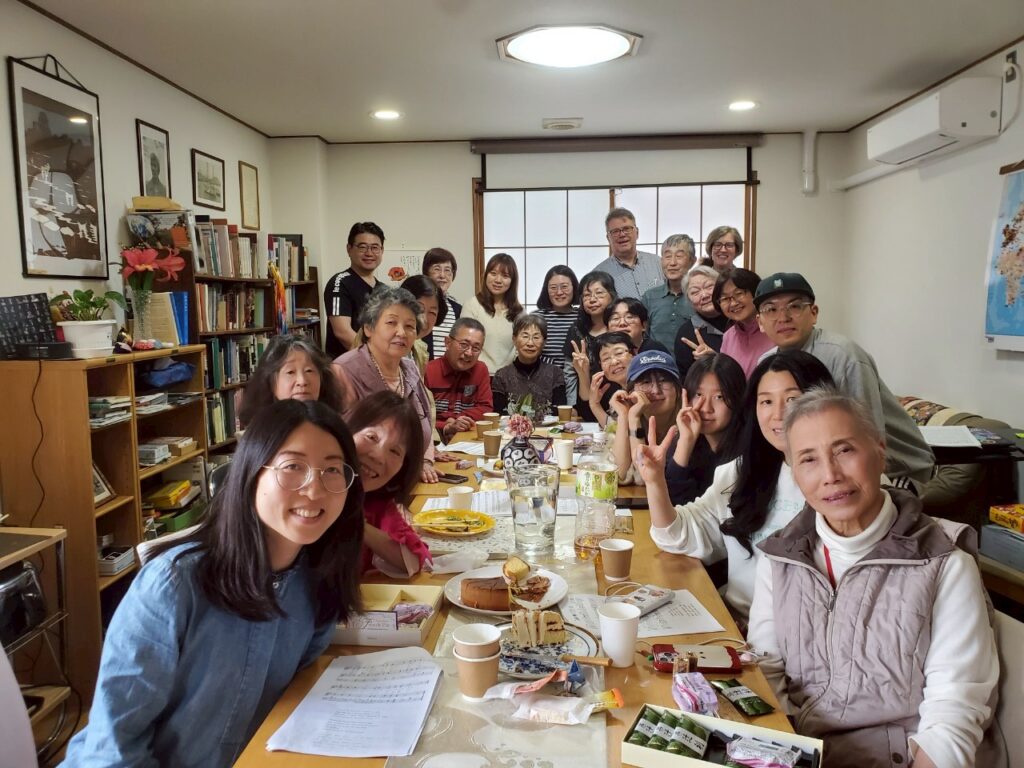
On the morning of May 1, the group arrived earlier than scheduled at Hiroshima Airport and took a limousine bus to Hiroshima City, where they were picked up and driven to WFC in the cars of the board members who met them. Lunch was a welcome potluck, prepared by members of the Peace Choir and others. Songs performed in Korean were heartwarming. Orientation with Brad talking about WFC and Barbara. We walked to Peace Park, visited the Barbara’s monument, and toured the Peace Memorial Museum. After that, they went to the homes of their host families, who took care of them for the next four days.
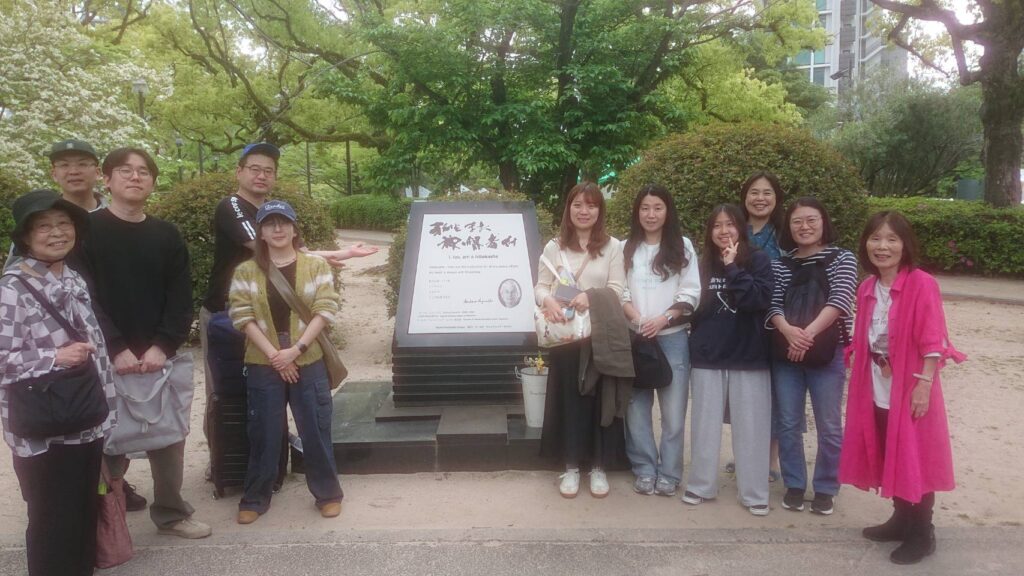
On the morning of May 2, we visited Hiroshima Korean School. Many of our members told us that this was the most impressive part of the program. We visited classes from daycare to high school, heard from the principal about the current situation of the Korean school, and then divided into three groups to have lunch with students from the junior and senior high schools. In the afternoon, we took a walk in Shukkei-en Garden, where we were assisted by Ms. Mariko Sunawaki and Ms. Yasuko Yamagata, members of the WFC community. After that, they had free time until the testimony in the evening, when they listened to a story by Mr. Jin Ho Kin, the president of the Korean Hibakusha Council of Hiroshima Prefecture at the WFC. Mr. Kin is a Hibakusha who was exposed to the bomb while in utero. He spoke directly to participants in Korean (as also done at the Korean school), and I believe that his story was conveyed to them more clearly.
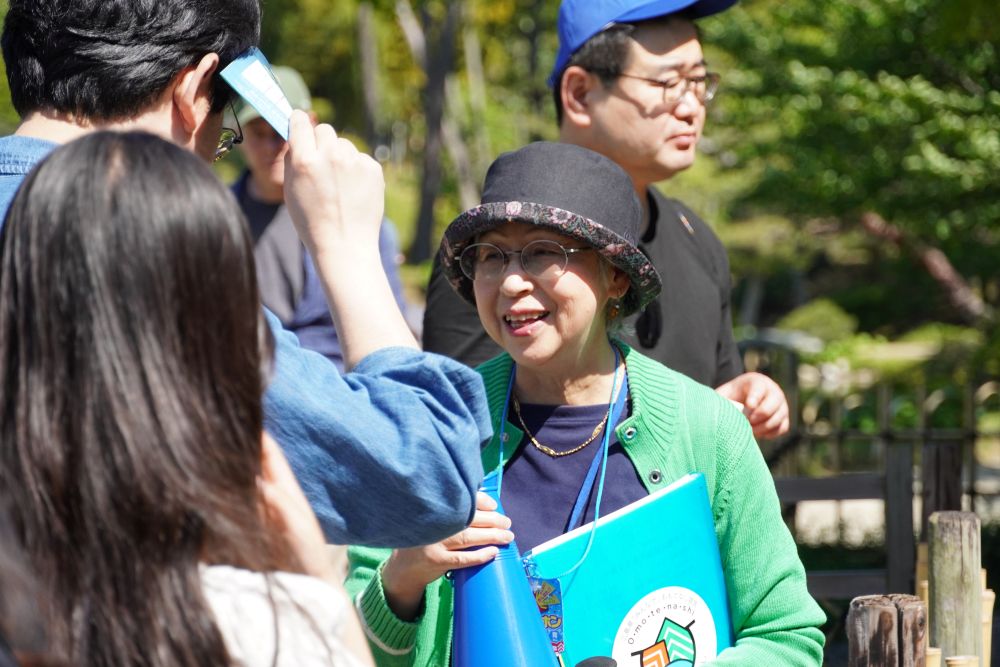
On May 3, we had a “Restorative Justice” workshop in the morning and a time of interaction in the afternoon. This is the second time we have had a public session on restorative justice, the first in 2023. With a desire to learn from each other, we planned an opportunity to learn about restorative justice, which is one of the important works of Peace Building, an exchange organization on the Korean side. After the program, we had free time. Everyone seemed to be fascinated by the newly opened Minamoa.
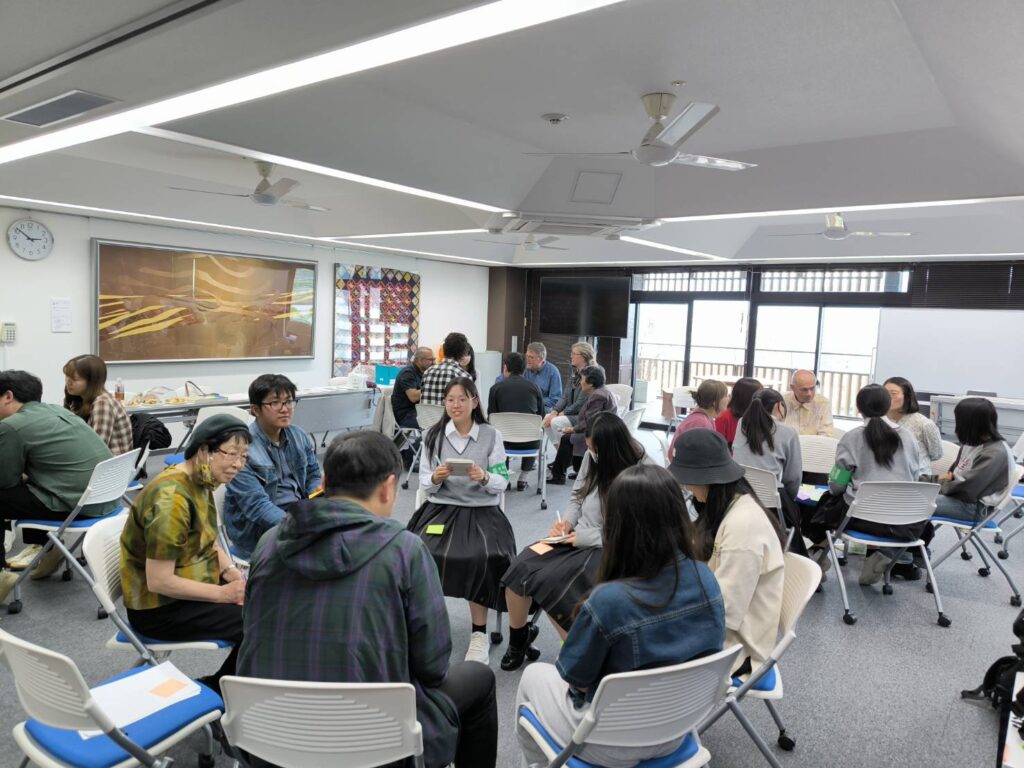
On the morning of May 4, Ayaka Fujita and Kou Motokura, two second-year students of the Hiroshima Jogakuin High School Signature Committee, led us on an English-speaking tour of the Peace Park monuments. They came to WFC in advance and worked hard to prepare for the tour, with support from Susan, the director of the WFC, who helped them with the guided study. For lunch, we had okonomiyaki near WFC. In the afternoon, we had a circle talk time to reflect on the four days and speak about what Japan and Korea mean to us through the experiences and words that printed in our hearts.
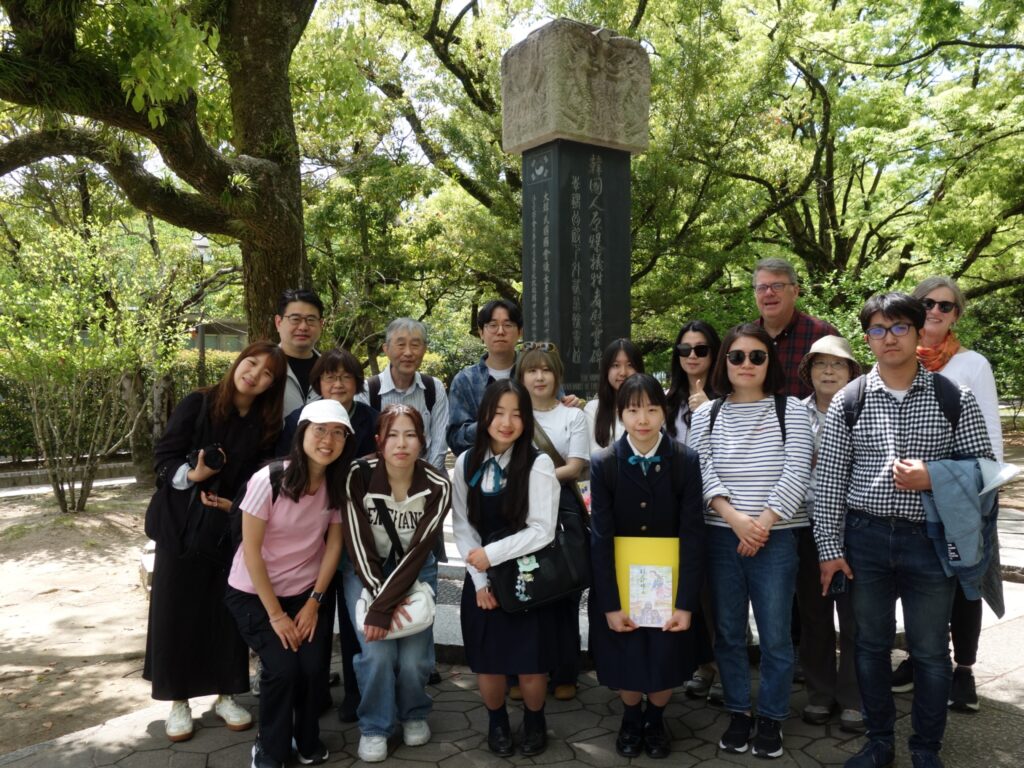
On May 5, the PAX enjoyed a sightseeing tour of Miyajima, joined by members who participated in the Korean PAX in different years, including a university student who returned home during the week, as well as members of the English class. Miyajima was so crowded with many visitors during the consecutive holidays, but they seemed to have had a good time enjoying nature (although there was an incident in which deer tried to eat their lunch boxes…). All the members stayed at the WFC that day. After the curry dinner we prepared together, we shared the message from each person and what we felt through Korean PAX. We received a commemorative plaque from the Peace Building community as a sign of our friendship over the years. Some members went to Minamoa at Hiroshima Station at the end of the day.
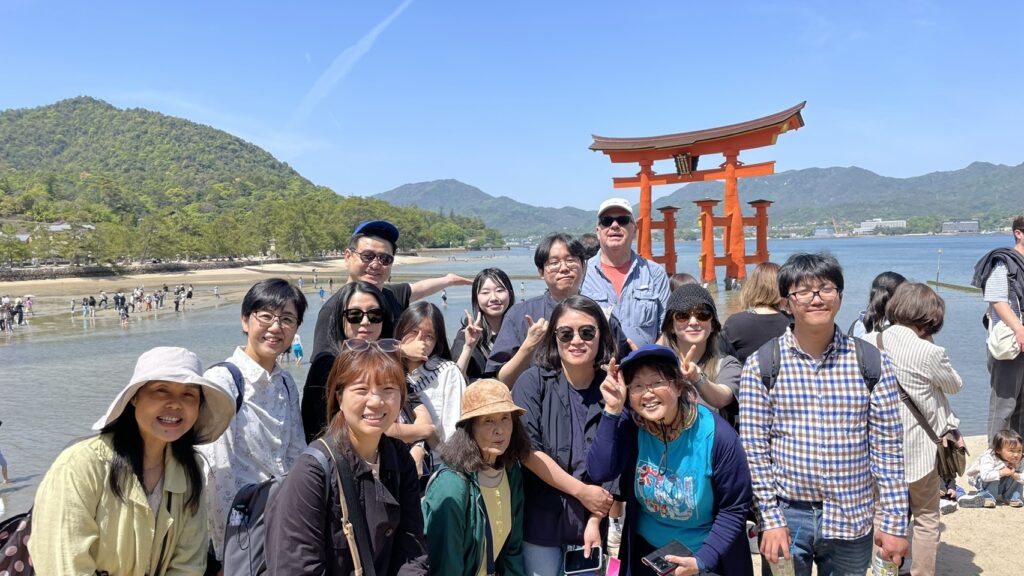
May 6. We were blessed with good weather during the Korean PAX, but it rained on the day they returned home. However, the weather was fine in the hearts. I am sure that each of us had various feelings and memories left in our hearts.
Korean PAX began in 2003. Over the 22 years since then, we have continued to visit each other, learn from each other’s past, and exchange ideas. Some of the members were surprised at how welcoming we were at the potluck lunch on the first day. Having visited Korea twice myself, I will never forget the warm hospitality I received from the Korean people. Likewise, I am sure that those from Korea will never forget the hospitality they received from their host families andthe WFC members. The photo shows a commemorative plaque given to us by the Peace Building community as a gift of gratitude. It reads, “We deeply appreciate WFC’s hard work and dedication to peace. We would like to express our gratitude for the long-standing friendship between the WFC and Peace Building and hope that solidarity for peace will be further strengthened.”
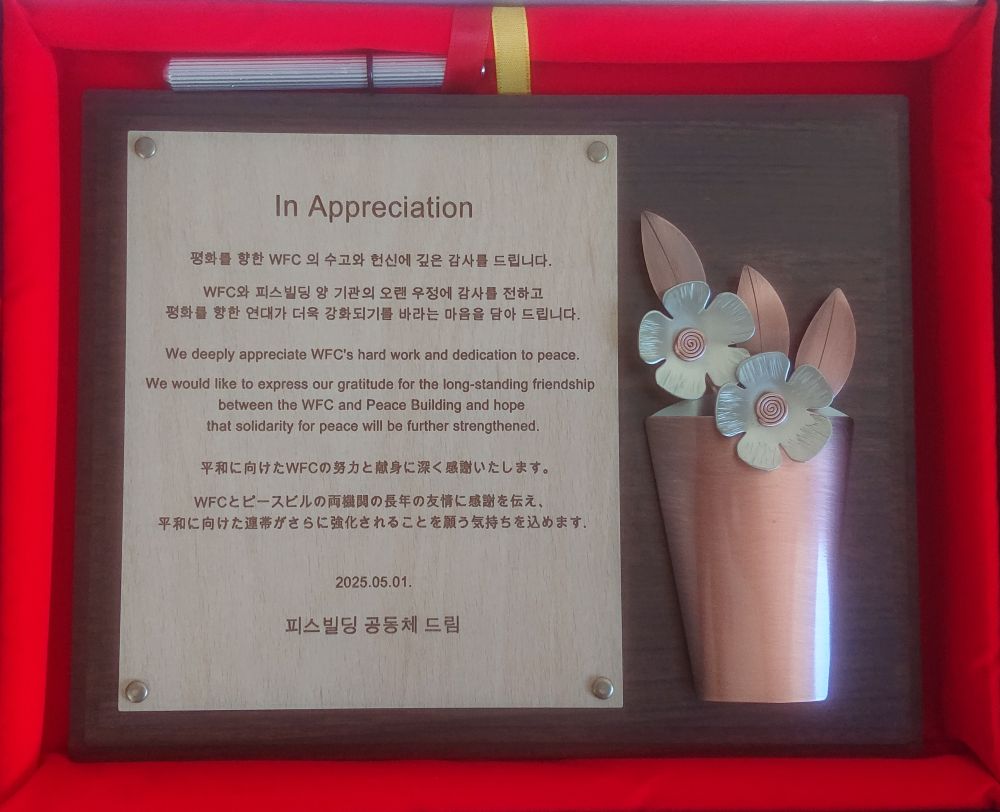
However, this was not accomplished overnight. I would like to express my gratitude to everyone who has visited Korea, everyone who has hosted members from Korea, everyone who has been involved in the planning and operation of the Korean PAX, and everyone who has supported the program.
And the relationship between WFC and the Peace Building will continue. This will require the presence of people who will be the carriers of the program and efforts to pass on what we have gained through learning from each other. This year’s Korean PAX included past participants of the Korean PAX program who have accepted host families, those who accompanied us for part of the program, and young members of last year’s program who joined us during their Golden Week break from universities. We would like to share with those around us what WFC has accomplished and cultivated through the Korean PAX programs, and would like to pass it on to the next generation.
A unique part of the program this time was a visit to a Korean school and hearing Hibakusha testimonies from zainichi, a Korean resident in Hiroshima. One of the participants mentioned this as one of the most moving parts of the PAX program. Just as the starting point for the abolition of nuclear weapons is the atomic bombing, we must never forget the starting point of our relationship with the people of Korea: why did people from the Korean Peninsula have to be exposed to the atomic bombing? Hibakusha are getting older, and it is becoming more difficult for them to participate in PAX. The same is true in Korean end. Last year, we were unable to meet with the members of the House of Sharing because they were hospitalized. Korean PAX is now entering a new stage of its history, while still valuing the importance of learning from each other.
U.S. PAX 2025 – application now open!
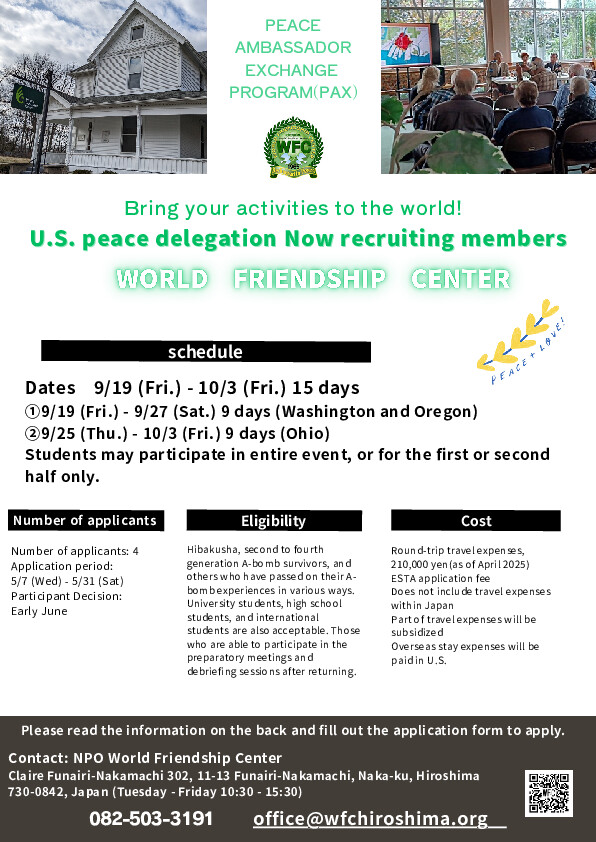
PEACE
AMBASSADOR
EXCHANGE
PROGRAM(PAX)
Bring your activities to the world!
Schedule: Dates 9/19 (Fri.) – 10/3 (Fri.) 15 days
①9/19 (Fri.) – 9/27 (Sat.) 9 days (Washington and Oregon)
②9/25 (Thu.) – 10/3 (Fri.) 9 days (Ohio)
Students may participate in entire event, or for the first or second
half only.
Number of applicants: 4
Application period:
5/7 (Wed) – 5/31 (Sat)
Participant Decision:
Early June
Eligibility: Hibakusha, second to fourth generation A-bomb survivors, and
others who have passed on their A bomb experiences in various ways.
University students, high school students, and international students are also acceptable. Those who are able to participate in the preparatory meetings and debriefing sessions after returning.
Cost: Round-trip travel expenses, 210,000 yen (as of April 2025)
ESTA application fee Does not include travel expenses within Japan
Part of travel expenses will be subsidized
Overseas stay expenses will be paid in U.S.
Please read the information on the back and fill out the application form to apply. In addition, please send a single A4 sheet of “how you can share with the American people about peace” to the following e-mail address.
Contact: NPO World Friendship Center
Claire Funairi-Nakamachi 302, 11-13 Funairi-Nakamachi, Naka-ku, Hiroshima
730-0842, Japan (Tuesday – Friday 10:30 – 15:30) 082-503-3191 office@wfchiroshima.org
Peace Ambassador Exchange In 1964, the World Peace Pilgrimage from Hiroshima and Nagasaki, organized by Barbara Reynolds, was conducted, which led to the creation of the World Friendship Center (WFC). The World Peace Pilgrimage, which called for the abolition of nuclear weapons and world peace, was a pioneering effort. The WFC held a panel exhibition to commemorate the60th anniversary of the World Peace Pilgrimage to Hiroshima and Nagasaki and provide an opportunity for the citizens of Hiroshima to learn about the World Peace Pilgrimage. The WFC had an opportunity to let Hiroshima citizens know about the World Peace Pilgrimage and how the spirit of the World Peace Pilgrimage is alive and well in the subsequent peace mission exchanges. The awarding of the Nobel Peace Prize to the Japan Confederation of A-and H-Bomb Sufferers Organizations (Nihon Hidankyo) has triggered recognition by people around the world of the importance of hearing A-bomb testimonies and of the importance of passing on the A-bomb experience. This year marks the 80th anniversary of the atomic bombing and the 50th anniversary of WFC’s sister institution, the Peace Resource Center at Wilmington University in Ohio, and the Peace Education Conference “Hiroshima and Nagasaki 30 Years Later”. In this milestone year, the U.S. PAX 2025 – Commemorating the 60th Anniversary of the World Peace Pilgrimage to Hiroshima and Nagasaki – will be planned and implemented with the cooperation of the Wilmington University Peace Resource Center. In the first half of the period, visits to the states of Washington and Oregon have been made possible with the cooperation of the American Committee of the WFC. In the places visited, the participants will convey the reality of the atomic bombings in schools, churches, and local communities, think about peace together with the American people, and appeal for the abolition of nuclear weapons and lasting peace from the standpoint of citizens through exchanges with them.
Peace Resource Center at WFC Wilmington College Founder Barbara Reynolds established the Peace Resource Center at Wilmington College after returning to the United States. We will participate in the commemorative events that will be held on September 29. Focusing on “nuclear abolition” and “the arts,” the symposium is an experiential symposium facilitated by artists to raise awareness of the need to abolish nuclear weapons as a means of achieving justice and peace in the region, nation, and world.
Forms of Peace: Presentations from US Peace Ambassador Exchange (PAX) Delegates
Please join us on August 4th from 10 am to noon at the International House to hear from four delegates visiting Hiroshima from America to share their various perspectives on peace. There will be time for Q&A after they share. We hope to see you there!
Contact our office to register.
office@wfchiroshima.org
080-503-3191
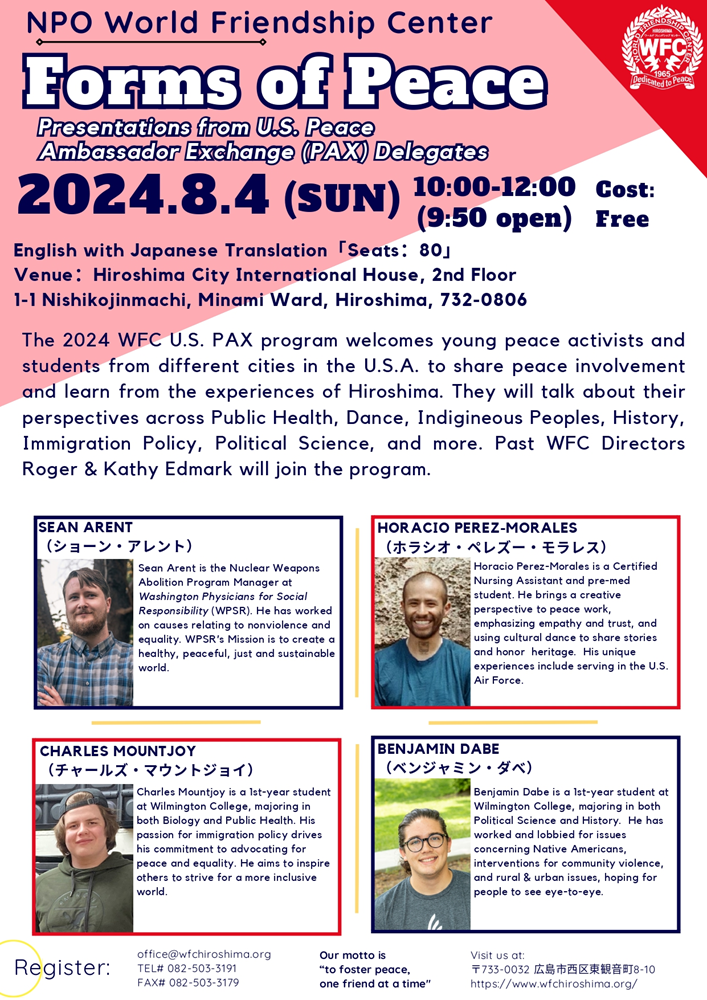
Friendship Hour, KPAX Debriefing Event
WFC held the Friendship Hour Korean PAX debriefing event on June 22, where members who participated in the Korean PAX (Peace Ambassadors Exchange Program) from April 27 to May 2 shared their experiences. A unique feature of this delegation was the participation of high school students, and the debriefing event was filled with energy and a fun atmosphere as five high school students gave their reports. The participants must have received a lot of energy from them. Of course, they shared not only their fun experiences, but also the history of the war they had learned in Korea and their interactions with Korean high school students.
There were participants from schools other than those participating in this program, and we hope that this program will spread to the younger generation. Thank you to everyone who participated in this program.
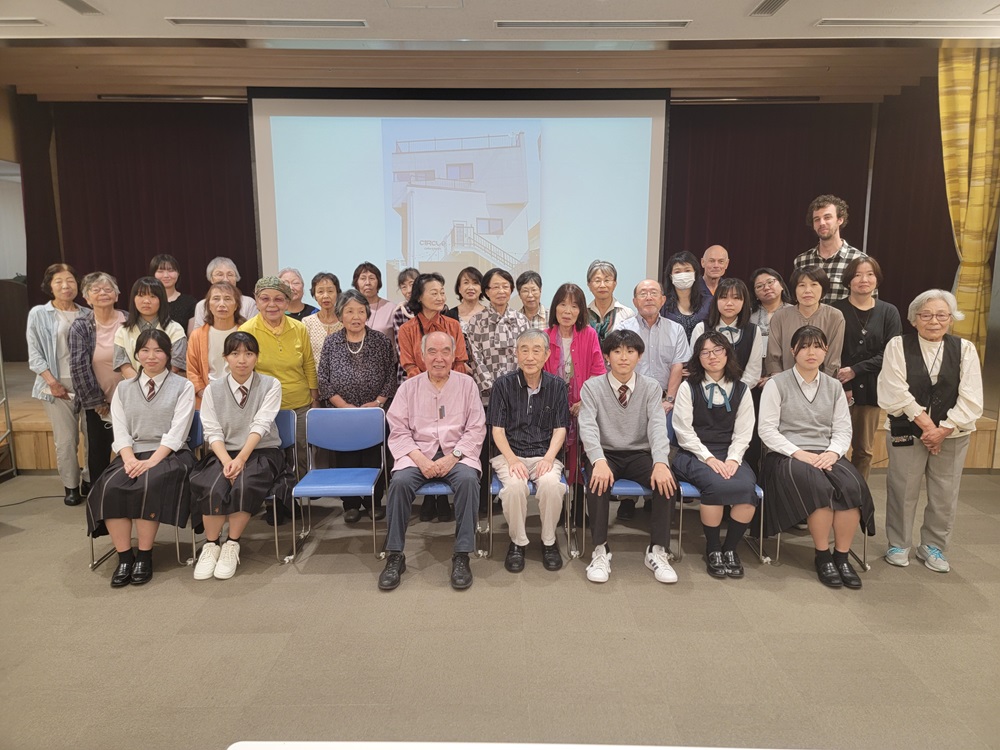
WFC Friendship Hour “US PAX Report (1/28)”
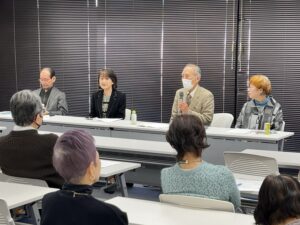 On January 28, WFC held a Friendship Hour for Okahara Tamiyuki-san, Horie Soh-san, Sunawaki Mariko-san, and Osawa Yuko-san to share about their travels to the U.S. as our PAX delegates. It was wonderful to see so many friends in attendance!
On January 28, WFC held a Friendship Hour for Okahara Tamiyuki-san, Horie Soh-san, Sunawaki Mariko-san, and Osawa Yuko-san to share about their travels to the U.S. as our PAX delegates. It was wonderful to see so many friends in attendance! 2023 Japan-U.S. PAX – application now open!
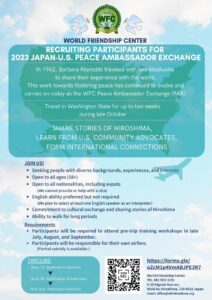 WFC has held American PAX (Peace Ambassadors Exchange) online for a couple of years due to the corona virus, but this coming fall, we will have PAX members from Japan visit the U.S. to conduct a face-to-face PAX.
WFC has held American PAX (Peace Ambassadors Exchange) online for a couple of years due to the corona virus, but this coming fall, we will have PAX members from Japan visit the U.S. to conduct a face-to-face PAX.
——–
Capacity: 4
Destination: Washington State
Dates: We are unsure of the exact dates, but it will be up to two weeks in late October.
JOIN US!
- Seeking people with diverse backgrounds, experiences, and interests
- Open to all ages (18+)
- Open to all nationalities, including expats (We cannot provide or help with a visa)
- English ability preferred but not required
(We plan to select at least one English speaker as an interpreter) - Commitment to cultural exchange and sharing stories of Hiroshima Ability to walk for long periods
Requirements
- Participants will be required to attend pre-trip training workshops in late July, August, and September.
- Participants will be responsible for their own airfare. (Partial subsidy is available.)
How to Apply & Application Deadline:
To apply for participation, please fill out this application form.
The deadline for applications is Monday, June 12.
——–
For more information, please download and review the flyer.
If you’d like to learn more about PAX, please take a look at this page for a brief introduction.
We look forward to receiving your application!
Spring 2023 US – Japan PAX
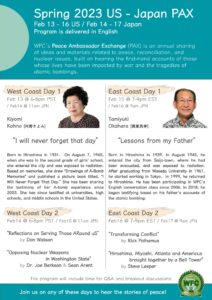 Spring 2023 US – Japan PAX
Spring 2023 US – Japan PAX
Feb 13 – 16 US / Feb 14 – 17 Japan
Program is delivered in English
WFC’s Peace Ambassador Exchange (PAX) is an annual sharing of ideas and materials related to peace, reconciliation, and nuclear issues, built on hearing the first-hand accounts of those whose lives have been impacted by war and the tragedies of atomic bombings.
Join us on any of these days to hear the stories of peace!
Spring 2023 US-Japan PAX Program
West Coast Day 1
Feb 13 @ 6-8pm PST / Feb14 @ 11am JPN
- “I will never forget that day” by Kiyomi Kohno
West Coast Day 2
Feb14 @ 6-8pm PST / Feb15 @ 11am JPN
- “Reflections on Serving Those ARound uS” by Don Watson
- “Opposing Nuclear Weapons in Washington State” by Dr. Joe Berkson & Sean Arent
East Coast Day 1
Feb 15 @ 7-9pm EST / Feb16 @ 9am JPN
- “Lessons from my Father” by Tamiyuki Okahara
East Coast Day 2
Feb16 @ 7-9pm EST / Feb17 @ 9am JPN
- “Transforming Conflict” by Rick Polhamus
- “Hiroshima, Miyoshi, Atlanta and Americus brought together by a Bell Tower” by Steve Leeper
*The program will include time for Q&A and breakout discussions.
Yu-Ai May issue 2019 — Korean PAX report by Keigo Nakamura
Yu-ai Friendship
Newsletter of the World Friendship Center, NPO
Participating in the Korean Pax
Keigo Nakamura
I learned many things and experienced many meaningful days while participating in the Korean Pax. For example, I learned about military comfort women and Korea in the Japan colonial period. I’d like to tell about four of my most impressionable experiences.
First, on the morning of the second day, I saw demonstrations held in front of a military comfort women statue near the Japanese Embassy. Many people participated in the demonstrations due to the day falling on May Day, including many students. Some, wearing yellow dresses like Jakie Chan, hit something like a sponge ball which had a face photo of Prime Minister Abe on it, which was interesting. Girl students and women with
their children also participated. I thought they were more interested in politics than Japanese people. Enjoyable activities like dances and songs were performed during demonstrations. I was surprised and interested, thinking that those looked nicer than in Japan. However, I also felt sad to see mothers participating with their small children, exposing them to Anti-Japanese sentiment at such a young age. Moreover, I had a strange feeling that I would betray my country joining this demonstration.
Second, I visited the House of Sharing. I learned about military comfort women when I visited the historical museum located on the spot where the House of Sharing was founded. I was a little bit tense because some Korean army soldiers were there. I had thought that Military Comfort Women would be all Chinese or Korean. So, I was surprised to know that
there were Japanese military comfort women too. I had an opportunity to meet former military comfort women and to hear about many things. One said to me, “I am able to forgive the present-day Japanese who were not born when I was a comfort woman. I am glad to hear your apology, but you are not responsible. My heart is not healed.” Her words impacted me deeply. She said that she wanted the Prime Minister Abe and Emperor Showa to apologize to her which made me understand what severe sufferings she had undergone.
Third, I went to Gyeongbokgung Palace. I often have seen historical Korean plays on TV, and was glad to see close-up the historical building which I saw in the TV program. I realized again that the Korean Palace was splendid. This was my second time to visit Seoul and Gyeongbokgung. I saw more black people and Westerners than the last time. I realized that Korea has become globalized.
Fourth, I experienced interaction with the host family in Korea. I was treated to Korean food – dak galbi on the second day of my visit, and to samgyupsal on the third day, as well as a Korean alcohol, mak goeli. While drinking together at that time, we talked about my grandfather and politics. Through this conversation, I learned about historical Korean plays, Korean children’s songs and the educational system of Korea. I had a friendly conversation with the host mother because both of us had something in common, learning Chinese a little. Given a lot of good sightseeing advice, I spent an enjoyable time while I was free on the fourth day.
Allow me to use this opportunity to apologize for having troubled many people when I got on the wrong train when I changed trains and got lost. I learned many things and had a valuable Golden Week. Karen invited me to participate in a summer camp in Nanjing which I’d love to do. I’d like to express my deepest gratitude to the host family in Korea, people of the Peacebuilding group that accepted the Korean PAX, and members of the WFC.
Translated by Sachiko Hiraoka
Copyright © NPO World Friendship Center 2019 All Rights Reserved
Yu-Ai May issue 2019 — Korean PAX report by Matsue Matsumoto
Yu-ai Friendship
Newsletter of the World Friendship Center, NPO
Participating in the Korean PAX
Matsue Matsumoto
I participated in the Korean PAX from April 30 to May 5. During this trip, I visited places where we usually could not go, and had very valuable experiences.
I participated in a protest meeting which was held in front of the Japanese Embassy on Wednesday May 1. The protest meeting is held on every Wednesday. In the afternoon, we went to Seodaemun Prison History Hall. On May 2, we visited the Comfort Women Historical Museum and met a Korean woman at House of Sharing. They both depicted negative legacies of the Imperial Japanese Army.
At the anti-Japan demonstration on Wednesday, a priest of the Methodist church offered his message and prayer. I couldn’t understand Korean, so I had no idea what he was saying. In the bible, Matthew 5:44 says “Love your enemies! Pray for those who persecute you!” I couldn’t understand what kind of message he offered and how he prayed for people in the demonstrations.
At the site of Seodaemun Prison History Hall, prison houses are preserved and open to the public. Activists in the independence movement were imprisoned here during the Japanese colonial period. The prison houses were also used by the Korean government after World War II. They were the buildings where tortures and death penalties were performed.
At House of Sharing, Tsukasa Yajima, a Japanese, showed us a video of the activities and protest of Ms. Kang Duk-kyung who was the first to proclaim the comfort women issue. We saw her pictures that she drew for her mental health. Each picture depicted her crying heart – a feeling I could share. After that, I met two Korean women. Their names and ages were the same. One of them looked calm as she told her story. I thought she had a strong will which would not be daunted and would persevere through anything. When I asked her “What do you want us to do? What do you want?” She answered, “Apology and compensation.” The other was a woman free from care.
On the night of the second day, I made an apology and told the A-bomb experience. During questions and answers session after my presentation, someone asked “Why don’t you ask America for an apology? You had terrible experiences due to the A-bomb.” I answered, saying “Many American people agree that the A-bomb ended the war sooner. The Japanese proverb says, ‘Leave the past in the past. Cover up what smells bad.’ Many Japanese don’t ask for apology. Some young Japanese don’t know that once Japan fought against America. Today, the power of nuclear weapons is about 4000 times as strong as that of the A-bomb dropped on Hiroshima. One bomb would contaminate half of the earth with radiation. From a humanitarian standpoint, such a powerful weapon must not be used. However, some countries possess them. I am making efforts to abolish nuclear weapons.” I don’t know whether they understood what I meant.
There is a culture of “hatred” in Korea we Japanese can’t understand. They harbor this feeling for a long period of time in their minds. However, Kim Yog-Won an author of Social Psychology (1989), points out that the Korean are very generous people and forgive others, and can accept their fate due to “hatred”. I think that both aspects are true. I can understand the Korean people seek for an apology from the top person for war responsibility. If the number of people who support the latter aspect is larger than that of the former, I think we can find a clue to reconciliation. Today, the relations between Japan and Korea are strained. I hope from now on, that young people try to solve the Japan-Korea issue.
Translated by Sachiko Hiraoka
Copyright © NPO World Friendship Center 2019 All Rights Reserved
Yu-Ai May issue 2019 — Korean PAX report by Minao Capper
Yu-ai Friendship
Newsletter of the World Friendship Center, NPO
Korea PAX
Minao Capper
On my trip to Korea though PAX I wanted to find out what the Korean youth feel about peace, understand more about the historical problems between Japan and Korea, and experience the Korean culture. I especially think I now understand the issue about the Korean women forced to be sex slaves by the Japanese military, and I could see it from a different perspective than before.
On the first day, we joined a protest in front of the Japanese embassy. I was surprised that there were many young people, even though it was a national holiday. They were very different from the Japanese students who just sit there quietly because they were told to, but instead they were actively chanting and singing songs. The young people taking it upon themselves to act on what they think is really impressive and inspired me a lot.
On the second day we went to the house of sharing and learned about the horrific things that the Japanese military made these women do in wartime.
When we heard from the Harumonis it made me think that the terrible things that we saw in the museum had happened to these women sitting in front of me.
That thought made me tear up. Going to a Japanese school and studying the Japanese peace education all my life, learning about the truth for the Koreans hurt my heart. All the Harumonis want is a formal apology and for the stories of the so called “comfort women” in the school textbooks. I can’t understand why the Japanese government can’t do that. I said this at the Q and A after Matsumoto san’s story on the third day but, I think if we don’t learn about our past mistakes, we will not be able to achieve a truly peaceful future.
During the Q and A on our third night, I got to see many different perspectives while translating, and when I was asked about what the Japanese youth think or what kind of peace education I had, I did my best to answer those questions but I felt I wasn’t answering the questions as well as I could. Not many people are as privileged as I am to be able to take part in such trips so at the very least, I want to tell my opinions and my experience in Korea to my friends and teachers in Japan.
On our final day we went shopping with my host family, Coco and Austin.
When we got back to the peace building we had diner all together then got in a circle to talk about our memories during our stay. I am so thankful for my amazing host family and all the people who made this possible. I will never forget this experience.
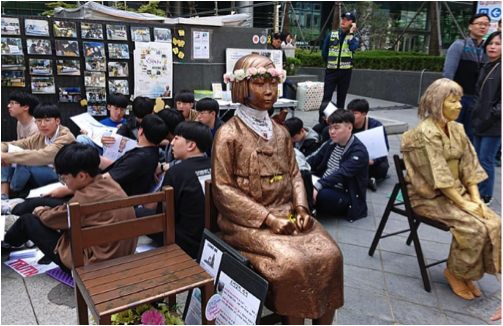
Copyright © NPO World Friendship Center 2019 All Rights Reserved